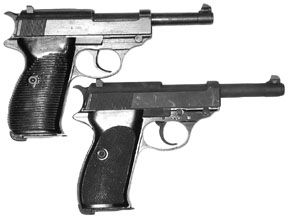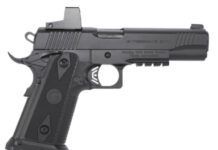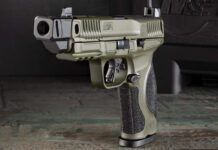
We remain mildly surprised by the ongoing interest Gun Tests readers have for tests of collectible, relic, or just plain old guns. Current manufacturing methods and materials are naturally much advanced over what they were 10, 20, 50 or 100 years ago, so on a quality and consistency basis, today’s guns are usually better picks if actual shooting is in the owner’s plans.
Still, we recognize the appeal of famous names and well-known designations, and because so few shooters still alive today had to use these guns in anger, there’s natural curiosity about them. Many shooters simply wonder how good they were, and how they stack up against today’s products.
We just tested a wartime P38 against a later P1, the latter being about the same as the P38 of WWII, but made for the West German army, and having an aluminum-alloy frame instead of the all-steel frame of WWII. Walther developed the P38 out of its PP, one of the very first double-action pistol designs. The P38 was adopted officially in 1938, hence the P38 (for Pistole) designation. About a million P38s were made during WWII by Walther, Mauser, FN, Brno, and several other manufacturers. Wartime guns were identified by a letter code. Our test P38 was made by Mauser in 1944, as noted by the “byf” and “44” markings on the slide.
Recent offerings were made of the P1 by various surplus gun outlets. The P1 was recently priced in several outlets so low as to be a bargain, in the realm of $200 to $250, though we doubt those prices still hold. Any decent 9mm for that low of a price could be considered a bargain, but when it has the Walther name on it, as our test pistol did, it’s amazing.
Because of their low asking prices and historical significance, we wondered how these two guns stacked up in a modern testing situation. Here’s what we found.
[PDFCAP(1)]
As expected, the machining on this gun was quite rough all over, though the bore looked fairly good. The finish was slightly pitted from rusting over time, but it didn’t really harm the overall effect, we thought. Most of the visible identifying or manufacturing numbers matched, and the fit of the gun was fairly tight, we thought, for wartime production.
The barrel of the P38 is a complex unit, being machined (as well as we could tell) out of the same block that held the breech-lock mechanism and the rails in which the slide moved. However, the slide and frame and associated parts of the locking mechanism are all complex machinings, the sorts of things one will most likely never see again in handgun production. As such, the old P38 provides a time window to what things were like in the distant past, making the gun not only a good collectible but also a valuable piece of handgun manufacturing history.
Our sample had a decent barrel. Most of the bluing was still visible, though as noted there were some age pits here and there. The black plastic, serrated grips were in fine condition. The sights on the early and wartime P38s were actually pretty good. The rear was a dovetailed, U-notched design that many a modern manufacturer could learn from, because not only did it provide an excellent part of the sight picture, it was also stovepipe-jam smooth for the weak hand. The front sight was a flat-top post, easily seen. It was dovetailed into a ramp, and had a numeral 6 on its side. Presumably there were different heights of front sight available to help zero the guns.
The P38 has an easily cocked external hammer, and the shooter would be well instructed to use it whenever possible prior to firing the gun. The DA pull stacked nicely, so double-action hits, we found, were actually not too difficult. The magazine release was at the base of the grip, easily worked, though it took both hands to change the magazine. The mag held eight rounds in a single stack. The grip girth of the P38 measured 5.8 inches, which would make it not that comfortable for those with small hands. A 1911 has a girth of 5.3 inches. The only controls were a safety on the left side of the slide, which dropped the hammer when activated, so on older guns, make sure it works before you use it with live ammo; a slide-stop lever just above the trigger on the left side; and the takedown lever under the left front of the slide. This pistol had no provisions for lefties, but dexterous users would not have problems, we thought.
Takedown was very simple, and the same for both pistols. With the gun cleared of ammo and the hammer down, pull the slide rearward far enough that the takedown lever can be rotated through its arc of about 135 degrees. Then ease the slide off the front. The barrel assembly will then come out of the slide. It’s possible to remove more of the inner parts with relative ease, but that will generally not be necessary for routine maintenance. Reassembly of the wartime gun was a simple reverse of the above, but with the P1 we had to press down the spring-loaded ejector as the slide returned to its proper place.
We [PDFCAP(2)] with Black Hills 147-grain FMJ (subsonic) ball, Winchester 115-grain BEB, and Cor-Bon 125-grain JHP. We found the wartime gun’s magazine didn’t work with either of the latter two rounds, but fed the ball perfectly. We tried the P1’s crisper, newer magazine with its notably stronger spring in the older gun, and it then fed everything perfectly. Ejection (by both guns) was over the left shoulder, and the old gun shot reasonably well for us. Best groups were with the Cor-Bon, which gave consistent sub-2″ five-shot groups at 15 yards. The other two types showed varying degrees of vertical stringing, so an ammo search could pay dividends if accuracy is your game.
[PDFCAP(3)]
The main difference between the German army’s P1 and the old P38 is the frame, which is of black-finished aluminum alloy on the P1. The newer gun’s grips were well checkered, and gave better control of the gun than the old version. They were a touch smaller in girth too. The slide and barrel were matte black, probably Parkerized, and the gun was essentially new inside and out. The sight design was identical, but the front blade was wider — almost too wide for the rear notch, we thought. Both had a white dot to aid shooting speed. Trigger pulls of the two guns were very close to each other in overall feel and weight. We could feel a bit more recoil with the lighter, newer gun, but by no means did these guns have what we’d consider to be significant recoil.
This was an excellent handgun, we thought. It shot in the 2-inch realm, sometimes better, with the test ammo. Like the P38 it hit close to where it looked, so sight adjustments wouldn’t be necessary for most shooting. The P1 would do anything any modern 9mm would do, except conceal easily. Also, you’d probably have a hard time finding a modern holster to carry it. But for a fun gun, what’s not to like?
Gun Tests Recommends
• Wartime P38, about $400. Buy It. We thought the P38 was a fine collector piece that could find some uses today, though the P1 would be the better gun for most to shoot, having little collector value at this time. Finding a good P38 will only get harder and more costly as time passes, so if you want one, search the Internet, gun shows, and gun-listing publications. Try to find one with all matching numbers, like our test gun, if you have an eye toward a collectible. One of us found long ago that mismatched P38s can be horribly inaccurate. We tried the gun in fast pairs and found that it worked about as well as a modern Sig tested recently, so there’s plenty of life left in this ancient design, we thought. It was easy to shoot, looked good, and had its own aura.
• Walther P1, about $300. Our Pick. Yes, there are smaller, lighter 9mms out there. In fact we tried our Kahr PM9 against these two and found we could sometimes shoot groups as small with the tiny gun as with either of the P38s, but it was harder. Generally, the old and new designs of the P38 were closely matched for accuracy. If you have no great need to conceal a 9mm, one of these two might be ideal for you. We liked the P1 and thought it was a great buy, and it would be the one we’d choose if we were looking to experience this design first hand. Many wartime or prewar P38s are way too valuable to shoot. If something breaks, you’re out of luck for many original replacement parts. But the P1 has no such limitations. We though it was a fine handgun, well worth having if you like the design. We suggest those interested in the design acquire the book Know Your P-38. It includes descriptions of all the codes and markings found on the pistols and what they mean.




























P-38 Values are contingent upon numerous variables including condition, whether wartime production and whether actually used in WWII to name a few. The presence of visible German Watermarks on each side of the slide would seem to support increased value correct? I haven’t researched the year of production, but that wouldn’t be time consuming or otherwise difficult. I’d say this P-38 is in good to very good condition and has factory supplied tools and booklet. There’s an Amazing GI story with this one. This one will stay with the family, no doubt.
I’d be delighted to forward pictures relative to help determine estimated value.
Just some thoughts.